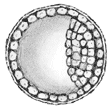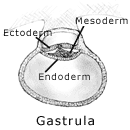|


Specialized cells have a common origin. What sets them on
separate paths?
by
Liza Gross
More
than two thousand years ago, the Greek philosopher Aristotle
first proposed that animals develop gradually in size, shape,
and complexity. He based his theory on what he observed when
he dissected chick embryos. But despite Aristotle’s findings,
his peers believed that animals were fully formed from the
earliest stage of embryonic development. As late as the seventeenth
century, some scientists thought a person appeared inside
an egg or sperm cell as a tiny but fully developed human,
the homunculus, and simply grew.
By
the nineteenth century, embryologists recognized that a fertilized
egg develops according to an exacting schedule, pattern, and
plan. It does not harbor a fully formed human, but it has
the potential to build one. That potential, we now know, comes
from a class of cells called stem cells. Stem cells have two
features that make them unlike any other cell: They can make
identical copies of themselves, and they can make differentiated—specialized—cells
such as nerve cells or muscle cells.
Though
most stem cells will ultimately meet separate fates, the biomechanisms
that control their destinies are largely the same. Master
genes coordinate a complex network of molecular, genetic,
and cellular signals that tell each cell what role it will
play in constructing a human being. These master genes act
as developmental regulators, directing specific sets of genes
to make specific proteins. Once a cell gets the signal to
make a protein specific to a particular type of cell, such
as a muscle cell, it has committed to becoming that type of
cell.
From
One to Many
|

|
|
Fertilized
egg
|
When
sperm and egg fuse during fertilization, the genes of
father and mother combine to form the full complement
of a human’s thirty thousand or so genes, or genome.
The fertilized egg creates not just the embryo but the
tissues needed to support it. About twenty-four hours
after fertilization, the egg divides in two. With every
subsequent division, a complete copy of the genome gets
passed on to each new cell, but only some of these genes
will be used in any one cell at any given time and place.

|
|
Morula
|
After
about seventy-two hours, the embryo forms a solid ball
of cells called the morula. That’s when the cells
part ways: Some move to create an outer rim; some remain
in the interior. Next, a fluid-filled cavity forms inside
the morula, and the interior cells secrete proteins that
turn the morula into a blastocyst, which implants itself
into the lining of the mother’s uterus.

|
|
Blastocyst
|
The
outer cells of the blastocyst contribute to the placenta,
as does the uterine lining. The inner cells are stem cells
that will spawn the more than two hundred types of cells
that make up the human body.
 As
the cells inside the blastocyst continue to divide,
they undergo gastrulation, arranging themselves in three
layers to form a gastrula. These three cell layers—ectoderm
(outer), mesoderm (middle), and endoderm (inner)—produce
all the body’s tissues, organs, and systems. The
nervous system and outer layers of the skin, for example,
come from ectoderm cells; heart, kidney, bones, and
muscles from mesoderm cells; and lungs, liver, and pancreas
from the endoderm.
As
the cells inside the blastocyst continue to divide,
they undergo gastrulation, arranging themselves in three
layers to form a gastrula. These three cell layers—ectoderm
(outer), mesoderm (middle), and endoderm (inner)—produce
all the body’s tissues, organs, and systems. The
nervous system and outer layers of the skin, for example,
come from ectoderm cells; heart, kidney, bones, and
muscles from mesoderm cells; and lungs, liver, and pancreas
from the endoderm.
|
Stem
cells also respond to signals from their neighbors, which
tell them to activate genes that make proteins controlling
how they will move, differentiate, and adhere to other cells
to build tissues. Over the course of embryonic development,
different sets of genes will be retired and others called
to duty in the service of transforming these amorphous stem
cells into single-minded specialists.
There
are two kinds of stem cells
—embryonic and adult.
Embryonic stem cells have the potential to become any type
of cell except those that form the placenta,umbilical cord,
and other embryo-supporting tissues. Discovering the molecular
signals that orchestrate embryonic stem-cell differentiation
will provide fundamental insights into the key mechanisms
of cell division and early development. This knowledge will
also lead to methods of intervening when something goes wrong.
Adult
stem cells are unspecialized cells that live in specialized
tissue, such as epithelial tissue in the skin. Their job is
to produce cells that maintain and repair that particular
tissue through- out an individual’s life. Adult stem
cells are hard to find and difficult to identify. Fewer than
one in ten thousand bone marrow cells, for example, is a blood-forming
stem cell.
Because
many diseases and birth defects arise when corrupted genes
disrupt the normal operations of healthy cells, many scientists
are focusing on therapies that replace damaged cells with
healthy cells. Embryonic stem cells offer enormous therapeutic
potential for a range of genetic and cell-based illnesses,
such as cancer and Parkinson’s disease, because they
can generate so many different types of cells. And because
these cells can make identical copies of themselves for extended
periods in the lab, researchers can produce the huge numbers
required for medical therapies. The embryonic stem cells typically
used in this type of medical research come from five-day-old
embryos, which have about two hundred to two hundred and fifty
cells. Most of these embryos are donated to research institutions
by clients of in-vitro fertilization clinics.
Until
recently, scientists thought adult stem cells existed only
in tissues and organs that required constant replacement,
such as skin, blood, and the lining of the gut, and that they
could produce only the cell types of their particular tissue.
But adult stem cells are turning up in unexpected places,
including the brain, and recent studies suggest that they
may be more versatile than once thought.
When
researchers at the University of Florida injected the coronary
arteries of a mouse with adult stem cells extracted from the
skeletal muscles of human volunteers, the human stem cells
differentiated into mouse heart cells. And researchers working
with mice at Cold Spring Harbor Laboratory in New York have
persuaded adult stem cells found in the nervous system to
become skeletal muscle cells.
But
not all adult stem cells respond to researchers’ attempts
to nudge them in different directions. Cell differentiation
most likely depends on activating a specific set of genes,
and forming the appropriate types of proteins; finding the
right combination of genes and proteins is a monumental task.
It’s also unclear how long these adult cells will self-renew.
That’s why embryonic stem cells still seem to offer greater
therapeutic potential: They have been seen to proliferate
for more than a year in the laboratory and can give rise to
a wider variety of cell types.
Though
we’ve been looking at stem-cell differentiation in humans,
the genetic and molecular pathways are similar in most
sexually reproducing animal species. And as researchers enlist
more and more organisms in their search for the biochemical
underpinnings of development, they’re finding the same
processes in species after species.
Looking
at organisms as diverse as worms, flies, and humans, researchers
at Massachusetts General Hospital and Harvard Medical School
found the same gene regulating the timing of key developmental
stages in each one. This suggests that the gene evolved nearly
a billion years ago (with the first animal, a spongelike creature)
and was inherited by nearly all subsequent animal species.
The
presence of this and many other regulatory genes in so many
different animals suggests that the mechanisms of animal development
are universal. Like so much of biology, every discovery peels
back the apparent difference among species to reveal an underlying
unity.
-------------------------
This
story originally appeared in the Cells issue of the "Exploratorium
Magazine."
CREDITS:
Micrographs by Kristina Yu, Microscope Imaging Station, ©
Exploratorium, using a Zeiss 200m Axiovert and Metamorph software
under a grant supported by the National institutes of Health
and the David and Lucille Packard Foundation. Illustrations
by Gary Crounse.
EXHIBIT
SECTIONS
:
The Stuff of Life
,
Life Needs Energy
,
Making
More Life
,
Change Over Time
©
Exploratorium
| The museum of
science, art and human perception|
Traits
of Life
|

